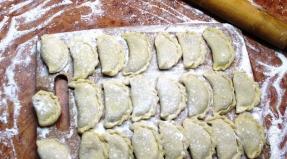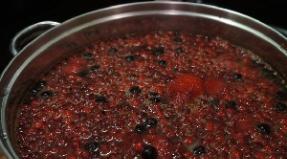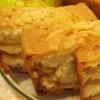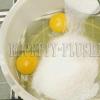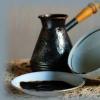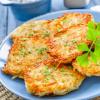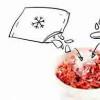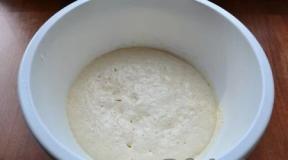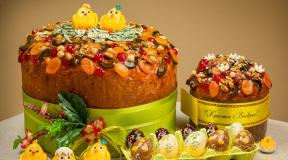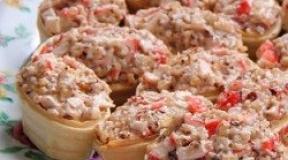How to cook Moldavian. Moldavian cuisine: recipes with photos
Moldova is a land of grapes, fruits and various vegetable crops, as well as poultry and sheep breeding. Therefore, she uses all her wealth, offering guests aromatic, unique and satisfying dishes for every taste. Today, Moldovan national cuisine is increasingly attracting the attention of many culinary experts, as it is rich in interesting dishes. Recipes for vegetable dishes and snacks are quite varied. So, mititei (elongated cutlets), mamalyga, served with meat and cracklings, is considered to be a traditional dish. From soups, the deputy and chorba gained great popularity, and flour products became famous due to vertuta. And what are Moldavian placinas worth? Of course, any treat becomes even tastier when served with a glass of the famous Moldovan wine.
A bit of history
Today we will consider some of the world's popular dishes from Moldova. Before doing this, let's take a short excursion into history.
So, the Moldovan cuisine was formed gradually. It is only natural that it was influenced by neighboring countries with different cultures, because Moldova is located on one of the most ancient and bustling trade routes.
During the tenth to twelfth centuries, a large number of Greek dishes entered this cuisine. In addition, Moldovans mastered the technologies of cooking butter, puff pastry and puff pastry, which at that time were practiced by southern European and Mediterranean chefs. There was also an experience of using olive oil, dry wine and spices for cooking vegetable and meat dishes, sauces.
From Turkey, Moldova took a penchant for the use of lamb meat in cooking, from the Slavic peoples - a love for pickles and pickles.
Thus, Moldovan cuisine has formed into a holistic structure with pronounced characteristics, organically combining different, sometimes contradictory influences, managed to find the most successful combinations of products in order to create a vivid colorful picture of natural ingredients, which is so loved all over the world.
Let's take a closer look at what Moldovan cuisine is. The recipes with the photos suggested below will help us with this.

Chorba with pork
Ingredients: five hundred grams of pork and veal ribs, one stalk of leeks, one carrot, one small head of cabbage, large parsley root, one spoonful of tomato paste, one onion, two bell peppers, one glass of green beans, two tablespoons of lard or lard , five potatoes, as well as two stalks of green onions, two glasses of Moldavian kvass, two tablespoons of parsley, dill to taste, salt, pepper, bay leaf.
Preparation
Moldovan dishes like this turn out to be very satisfying and tasty, since they contain nutritious components that contain a large amount of vitamins and minerals.
So, the breast is washed, dried and cut into two pieces with a rib for one serving. Then they are fried on lard until golden brown, adding pre-chopped leeks at the end. All this is put in a saucepan, poured with hot water and brought to a boil. Then remove the foam, salt, add herbs, pepper and continue to cook until the meat is cooked. Then the brisket is removed, and the broth is filtered.
Onions, carrots, parsley root, one sweet pepper are chopped into strips, sautéed in lard or lard, tomato paste is added at the end and fried for about a minute more. Put two whole sweet peppers in the broth, bring it to a boil, add beans, diced potatoes, prepared vegetables and cook until tender.

Meanwhile, chopped cabbage is fried in vegetable oil until golden brown. It is sent to the soup two minutes before it is ready. Moldavian kvass is heated separately, filtered, added to the broth along with salt, bay leaves, parsley and dill and boiled for two minutes.
Moldovan dishes such as chorba are served in portioned plates, where two pieces of meat are placed beforehand, sprinkled with herbs and fresh green onions on top. The food is obtained with some sourness.
Moldavian placinths
Ingredients: five hundred grams of milk, forty grams of fresh yeast (one pack of dry), one spoonful of salt, one spoonful of sugar, five eggs, fifty grams of margarine (two tablespoons of vegetable oil), one kilogram of flour, half a cabbage, four onions, and ground pepper, vegetable oil, five potatoes.
Preparation
Moldovan cuisine offers very interesting dishes. Placinths are a direct confirmation of this. Local chefs recommend making these pastries as follows. First, prepare the dough. To do this, crumble yeast in a container, sprinkle it with sugar, add two tablespoons of warm water and leave until they are completely dissolved. In the meantime, beat eggs with salt, add warm milk, and then prepared yeast, mix everything well and begin to pour flour. In the process of kneading the dough, add soft margarine and a few tablespoons of vegetable oil. At the same time, the dough should turn out to be soft, cover it with a towel and leave it to come up.

Preparation of the filling
How to make further Moldavian placinas? You need to prepare the filling. To do this, chop the cabbage, cut the onion into cubes, mix everything, salt and put in a preheated pan to stew in vegetable oil. Boil the eggs, add to the finished cabbage, pre-cut into strips, mix and leave for ten minutes. Peel the potatoes, grate them with onions, add salt and spices, add cracklings.
Formation of "envelopes"
The dough is divided into small pieces, each rolled out with a rolling pin to make a circle. Put the filling (cabbage or potatoes) in the center of each, spread it all over the cake. Then one edge is gently pulled out and applied to the filling towards the center. Then they take the edge on the other side and do the same. Similar manipulations are done with the rest of the edges. The result should be an envelope.
Heat the oil in a frying pan, put the placinde upside down and fry, then turn it over and continue to fry until golden brown.
Hominy
Ingredients: two glasses of cornmeal, three glasses of water, salt to taste.
The finished dish is served with feta cheese, cracklings, sour cream or ghee. It all depends on personal and taste preferences. When serving, hominy is spread on a dish with a spoon, which is moistened with cold water, poured with butter or sour cream, sprinkled with goat cheese or cracklings.
How is hominy prepared? Moldavian cuisine knows two recipes. Let's consider each one separately.

The first way
The cornmeal is dried in the oven for a few minutes so that it becomes dry and free-flowing, but not toasted. They cook hominy in a cauldron. Put salt and some of the flour in boiling water and mix thoroughly so that no lumps form, cook for five minutes. Then they add the rest of the flour with a slide, circle it around the walls of the cauldron with a wooden spoon so that it does not touch them. From above it is divided into four parts and cooked like this for twenty minutes under a closed lid. After the specified time, the lid is removed, the contents of the cauldron are quickly kneaded, leveled and soared over low heat for three minutes. After that, the hominy is removed and left to infuse for fifteen minutes.
Moldovan cuisine invites everyone to try its national dish. But before that, it must be laid out on a wooden board and covered with a linen towel for five minutes. Then the lump needs to be cut into pieces with a harsh thread.
Mamalyga is often served with chorba instead of bread. They use it by dipping it in butter with cracklings or sour cream with feta cheese.

Second way
Add salt and four tablespoons of flour to a cauldron with boiling water, stir well, bring to a boil, add the rest of the flour, stir thoroughly and cook over low heat. Then the finished dish is collected with a spoon from the walls of the container in the middle, the surface is leveled, poured with oil and left to cook for another fifteen minutes. In this case, the dish turns out to be somewhat thinner.
Mititei
Moldovan cuisine, the recipes of which we are considering today, is rich in vegetable dishes, but meat dishes are also not uncommon in it. Mititei are made from beef on a grill (wire rack).
Ingredients: eight hundred grams of beef, thirty grams of bacon, one hundred grams of fatty pork, five cloves of garlic, half a spoonful of soda, five tablespoons of water, salt, herbs, red and black pepper to taste.
Preparation
Moldovan cuisine is very original, and you can see it for yourself by preparing this delicious treat. So how to cook mititei? For this dish, you need to take two thirds of the first grade beef and one third with connective tissue, then it will turn out more magnificent. If the meat is lean, it is recommended to add lard.
So, the beef is washed, freed from tendons and films, cut into small pieces, salted, mixed and put in a bowl for three hours to marinate. After that, it should be removed for one day in the refrigerator, after having covered the container with a lid.

Fry on a wire rack
Over time, the beef is passed through a meat grinder along with the pork, a mixture of peppers, soda, water is added, kneaded and beaten on the table. After all that has been done, the minced meat is left for four hours in the refrigerator. Then sausages are formed from the resulting mass (using a meat grinder or manually). Put mititei on a greased baking sheet, grease them with fat, put a second layer on top, and put everything in the refrigerator. Meanwhile, grease the hot grate with lard, put blanks on top and fry on both sides until golden brown. Green peas, fresh tomatoes, onions or green onions, various pickles are well suited to the finished dish. The sauce is served separately.
It should be noted that if there is no grater, then the sausages can be fried in a pan or baked in the oven. On the wire rack, the dish turns out to be a little dry, on the griddle - juicy.
Finally
The dishes of Moldovan cuisine (the recipes presented in the article are just a small part of the entire culinary variety of this sunny country) are distinguished by their excellent taste. In the past, they were considered simple and therefore not worthy of attention. And completely in vain. Simple does not mean dull and trite. Today, Moldovan cuisine is popular, its dishes are appreciated not so much because of the wide variety of recipes (this can hardly surprise anyone), but because of the successful combinations of various products and flavors.
National Moldovan cuisine is called a treasury of unique recipes. And this is not surprising. After all, Moldova itself is fabulously rich in all kinds of products and methods of their preparation. This has been the case since antiquity, since she was at the right time in the right place. Simply put, the country was on the busy route "from the Varangians to the Greeks", which Byzantine and Greek merchants used to transport overseas goods. Needless to say, they subsequently "shared" with the Moldovans not only them, but also small culinary tricks that local housewives immediately used in everyday life.
History
As mentioned earlier, the true Moldovan cuisine has its origins in ancient times. True, it was influenced not only by territorial features, but also by individual stages in the development of other peoples.
Judge for yourself: in the X - XIII centuries. Moldavia was part of the ancient Russian state, from 1359 to 1538. - remained independent, then for almost 300 years was under the rule of Turkey, and in the XVIII century. became part of the Russian Empire and remained it for almost a hundred years until the union with Wallachia and the formation of "Romania".
All this involuntarily affected the culinary traditions of the Moldovans, although they themselves did not lose touch with the Hellenic, Byzantine culture and Greek customs. The best confirmation of this is the Greek dishes that have taken root in the Moldovan cuisine, for example, placinta and vertuta. And, of course, culinary customs and techniques that are typical for southern European and Mediterranean cuisines.
First of all, it is a special affection for butter, puff and stretch dough. Also, this is the frequent use of vegetable oils, olive and sunflower, the use of dry grape wine in the preparation of meat and vegetable dishes or the creation of spicy-savory sauces for them.
The Turkish influence is evidenced by the combined processing of products, the frequent use of lamb and, of course, the joint dishes for both peoples (givech, chorba). By the way, the Slavs also left their mark on Moldovan cuisine, sharing recipes for pickling and pickling vegetables, as well as making cabbage pies and cakes.
They say that thanks to all this, Moldovan cuisine subsequently became whole, unique and even international. The kind that she is known and loved all over the world today.
Specific traits
The features of Moldovan cuisine are:
- widespread use of vegetables. Here they are stewed, pickled, salted, fermented and simply eaten raw. Sweet peppers, tomatoes, eggplants, zucchini, various types of beans have been held in high esteem for many years;
- richness of meat dishes - it happened so historically that Moldovans equally love pork, lamb, beef, poultry meat. Moreover, most often they are cooked over an open fire using gratara - an iron grate laid over hot coals, or in portioned pots. They are served respectively with hot or cold sauces based on dry wine or tomato juice with vegetables;
- active use of spices and herbs - most often these are garlic, tarragon, pepper, thyme and cloves;
- originality of soups - they all have a characteristic sour taste and a huge amount of vegetables and herbs. The most popular soups are chorba and zama;
- a variety of salads - they are prepared here from vegetables and fruits, fish and meat, and, of course, greens and served cold immediately after dressing. Moldovans know a lot of recipes for such dishes, as they make them in a new way every time, simply by modifying the set of ingredients;
- abundance of fish - fish dishes are very fond of in Moldova. They are baked here, boiled, fried, including deep-fried, and served with a lot of vegetables;
- sincere love for corn - porridges, soups and main dishes are made from it, including the famous hominy. It is also called the local bread, as it is made from densely boiled corn flour, which is then cut into portions. Many people mistakenly believe that it has been here since antiquity. In fact, corn was brought to this region in the 17th century. At first it was considered exclusively the food of the poor, and only later it was "made" of it a national dish;
- the abundance of dairy products, however, most of all Moldovans love feta cheese.
But the most interesting thing is not so much the dishes themselves as their presentation. In this country, they know a lot about design and skillfully use it.
Basic cooking methods:
In Moldova, you can and should try absolutely everything! But due attention must be paid to her pride - national dishes. And there are plenty of them here!
The same hominy. Italian polenta is said to be its ancestor.

Vertuta and placinta are pies made from stretched dough with different fillings (cottage cheese, vegetables, fruits, eggs and even nuts). Their main difference is their form. Vertuta is a roll, while placinta is a flat cake.

Chorba is a favorite first dish, which is a soup with vegetables and herbs on bread kvass.

Mititei - grilled sausages.

Malay is a corn pie.

Syrbushka - vegetable soup with curd whey with corn flour.

Zama is another version of bread kvass soup. It differs from chorba in a large number of vegetables.

Macareths are dried peppers.
Moldova is a rich land, land of grapes, fruits and various vegetables, which is facilitated by favorable natural and climatic conditions. It is not surprising that Moldovan cuisine has been using all these riches for a long time. But in addition to natural conditions, the development of Moldovan cuisine was greatly influenced by the historical fate of the Moldovan people, the location of Moldova at the junction of countries with different cultures, on one of the most ancient trade routes.
Brynza is one of the types of brine cheese made from sheep's milk, it requires extremely short aging (1-1.5 weeks), has been prepared in Moldova since ancient times in large quantities, is based on the traditional sheep breeding here, which was most developed in the 17th-19th centuries. when it was the leading branch of the Moldovan economy. Cheese is used not only as an everyday snack in its natural form, but also in grated form as an addition to vegetable, egg, flour and meat dishes.
In comparison with feta cheese, corn has become a typical product for Moldovan cuisine relatively recently - only 200 years ago. It was brought to Moldova only in the 17th century. and spread widely in the 18th century, becoming, first of all, the daily food of the poor. Over time, people in Moldova learned how to cook various dishes from corn. The national mamalyga porridge is famous, corn is widely used in soups and side dishes, it is boiled and baked. At the same time, wheat rather than corn bread is traditionally used in Moldova.
Vegetables play a huge role in Moldovan cuisine. Side dishes and independent dishes are prepared from them. Most often they are boiled, baked, stuffed, stewed and salted, less often they are fried. The favorite and specific vegetables for Moldovan cuisine are grain and green (string) beans, lentils, tomatoes, gogoshars, bell peppers, eggplants, and zucchini.
Legumes are often mashed, beaten with onions and vegetable oil. The rest of the vegetables, especially peppers, eggplants, and gogoshars, are usually stuffed with either other vegetables or rice with vegetables and meat. Very often vegetables are used with sauces, marinades and other dressings made from wine, sour cream, spicy vegetables and spicy herbs. Various vegetables stewed over low heat with vegetable and animal fats and spices are used to prepare various vegetable stews - givechi and moussaki, which have a pleasant taste. Cheese and sour cream are often added to such vegetable dishes.
Of the spicy herbs and spicy vegetables, the greatest demand is for leeks (prague) and celery, which are used in Moldova in large quantities not only for seasonings, but also as independent dishes.
Other spices include coriander in seeds, black and allspice, cloves, bay leaves, tarragon, especially in pickles. Garlic is also widely used, which forms the basis for two common national Moldovan gravies - muzhdeya and scordoli, and also goes into all meat and vegetable dishes, especially from legumes. In Moldovan folklore and beliefs, garlic is endowed with miraculous powers. In the past, in Moldova, with its hot summers and damp winters, it was a folk remedy used with food.

Moldovan cuisine, as noted above, is characterized by tolerance for the perception of the culinary customs of neighboring peoples. This is easily seen in the example of meat dishes. Moldovans use in their national dishes to the same extent mutton (chorba, givech, moussaka), and pork (kyrnetsi, bone, fly), and beef (mititei), and poultry (zama). At the same time, a clear preference is given to young, tender meat of calves, lambs, young cockerels and chickens. Meat is cooked necessarily in combination with vegetables, in relation to which it makes up a small part in such dishes, as well as in combination with fruits (veal - with quince, turkey - with apricots).
A characteristic of Moldovan cuisine is the combination of dry wine and tomato juice in meat dishes and sauces. This gives the meat a special tenderness and at the same time makes it more piquant, which makes Moldovan cuisine related to the cuisines of other Romanesque peoples.
The technology of cooking national meat dishes is characterized by the use of open fire and gratara. Gratar is preliminarily greased with oil, bacon or animal fat, meat or poultry is put on it either in a piece, or in chopped and then compressed form (shot, mititei, kyrnetsey). An oven is usually used for extinguishing, rather than a stove fire. A description of traditional Moldovan cuisine would be incomplete without mentioning flour products: placinths, Easter cakes, Easter cakes, dumplings, etc. Walnuts are very popular.
Greetings, dear guests of the site! for its traditional dishes, it is considered one of the healthiest cuisines in the world. And this is not an exaggeration at all - the climate of Moldova is ideal for growing fruits, vegetables and cereals. The variety of plant foods practically leaves no room for meat on the table of Moldovans, Gagauz and Bulgarians living in the territory of modern Moldova.
About what Moldovan cuisine is rich in, what dishes are the hallmark of this country, what chorba, zama and vertuta are, and much more interesting. By the way, I haven't written anything on the site for a very long time - so maybe you can guess why this particular article came out?
There is an opinion that the cuisine of Moldova does not exist at all. This, of course, is not the case. It may not be so bright as to shine in restaurants, but nevertheless it is there, and it has its own characteristics that are simply impossible not to notice (I will talk about them later).
Of course, it was not done without borrowing from Turkish, Greek, Russian, Balkan and Romanian cuisines. It is quite normal for neighboring cultures to influence each other, this is always the case. It is worth noting, however, that none of the recipes were copied completely unchanged. In every dish, Moldovan chefs and culinary specialists put their own zest, this is a creativity in which all parts of the world are combined on one dining table.
What dish is the hallmark of Moldova?
Let's start with the most important dish of this country - hominy! It is prepared from corn, more precisely from corn flour. By the way, corn itself appeared in the Moldavian principality relatively recently - about 300 years ago, and the dish from it has already acquired a national character. Mamalyga is a very ancient dish, and it was originally prepared from millet. It is believed that the Italian polenta is the ancestor of mamalyga.

This simple and at the same time very healthy dish has always been attributed to the food of the poor, and once in poor Moldovan families, hominy was a substitute for bread. It can be served as a separate dish, but usually something is added for taste: it can be sour cream, grated feta cheese, butter, milk, garlic, cheese, cracklings or mushrooms. The most interesting thing is that it is not customary to cut mamalyga with a knife, it is divided with a thread or broken by hands (I don’t know why with a thread: would it be easier to use a sharp knife? - but it just so happened, we will not betray ancient traditions). Then a piece of hominy is crushed in hands and dipped in sour cream or grated feta cheese.

This is, of course, a classic version of the preparation of hominy. I was once treated to a lazy hominy, i.e. pieces of hominy fried in butter mixed with feta cheese, and sour cream as a sauce - I really liked it. Other tasty modifications are also prepared from it: Sarmale - cabbage rolls or cabbage rolls with hominy; Urs - feta cheese is baked in hominy balls.

I must say that white bread takes pride of place with them: all my attempts to find pure rye bread were unsuccessful (see the article where I talk about the healthiest flour, guess which one?). Therefore, they know there a considerable number of recipes for pies, the most famous of which are: vertuta and placinte (placinda) (we visited a restaurant that is named after one of them: "La Placinte", located in Chisinau).

Both placinda and vertuta - both are prepared from stretched dough with various fillings: with cottage cheese, feta cheese, nuts, fruits, potatoes, with onions and eggs. Their main difference lies in the shape: a vertuta is a roll, rolled in a spiral, and a placinda is a flat cake. We tried cherry twirls - I was amazed at how much toppings they contain! It is immediately evident that there is a surplus in the country.

There are also baked rolls, cakes and apple pie known to us. Very often they use puff and butter dough for baking sweets, gingerbread with honey from corn flour, cookies with a layer of marmalade called semilune, shortbread biscuits. By the way, our famous cabbage pies got the name there - versere.
What sweets are typical for this cuisine?
The peculiarity of sweets consists in the use of mainly nuts, fruits and berries, which is very similar to typical oriental sweets. For example, quince and apple marshmallow, fruit and berry juice jelly, nut nougat, fruit marshmallow, soufflé, marshmallow, marmalade. Another characteristic feature of Moldovan sweets is the use of thick grape juice, a by-product in the production of wine is must. Fruits and vegetables are cooked in it.

The result of the evolution of Moldovan cuisine is the "Hat Guguta" cake. This cake has the shape of a pyramid, made from rolls with cherry filling, decorated with cream and meringue.
As I said, the climate of this sunny country allows you to grow a whole variety of vegetables: eggplants, zucchini, cucumbers, tomatoes, peppers, onions, carrots, beets and others. They are fried, steamed, stewed, baked whole, chopped - they make adjika, stuffed. You can see vegetables and legumes on the tables of Moldovans all year round in the form of salads, pickles, side dishes, with first and second courses. In the summer, people are engaged in harvesting pickles for the winter, cucumbers, tomatoes, peppers, and more. Look how much you can find in their basement at home - as I was told, this is still not enough.

The most popular vegetables here are sweet peppers, sweet peppers with a spicy taste, which has its own name - gogoshar, and, of course, tomatoes, onions, pumpkin, zucchini and eggplants. By the way, many of you probably like boiled corn. It has its own name there - popushy. As a rule, poop is served with salt, sometimes butter or spicy sauce is added to it. Legumes are also very popular here - various mashed potatoes are prepared from them: with onions, garlic and vegetable oil. The most common: beans - white and green beans, chickpeas, lentils.

What is the secret of the taste of Moldovan vegetable dishes?
A special place on the table of these peoples is occupied by feta cheese - brine cheese made from sheep's milk and sour cream. These dairy products are added to meat, fish, vegetable and flour dishes to add salty and other tastes, i.e. they act as if in the role of spices and at the same time make the dish more satisfying and nutritious.

In the same way, various hot sauces are widely used. For example, Moldavian scordola is a sauce made from walnuts with garlic, and muzhdy is a sauce made from garlic, salt and meat or vegetable broth. From spices in Moldova, they use in abundance: red, black and allspice, thyme, tarragon, leeks, garlic, celery, parsley, dill, tarragon, coriander, cloves, bay leaves, nutmeg, cinnamon.
How are the first courses prepared?
The soups they prepare represent a mixture of Russian, Caucasian and Mediterranean traditions. The most famous and beloved national soups: zama - soup made from potatoes, onions, raw eggs and poultry meat; chorba is a soup cooked with fresh, not fried vegetables in meat broth and seasoned with fresh herbs and a sour drink, which I will talk about below, chorba is served with sour cream. There are also simple soups - for example, syrbushka - a soup with vegetables and cornmeal.


The national Moldovan drink, which is added to soups and other liquid dishes to add a sour taste, is sour bran kvass. This drink is very popular among the people.
What about meat?
There are no bans on any kind of meat. In the villages and villages, many keep geese, ducks and chickens, since it is easier to manage such a farm than to keep livestock. However, sheep, goats, lambs and even cattle are also present. The meat of lambs, calves and young chickens, geese and ducks is especially appreciated.

The main ingredient of meat is mainly in traditional ancient dishes of this region, and in modern cuisine it is more often used as an additional optional component of dishes. One of the ancient meat dishes is, for example, kostitsa - pork marinated in wine, baked over the fire; kifteluce - fried beef meatballs; resol - cock jelly; fly - smoked pork leg; whole chicken and geese. Very often, meat is fried over an open fire: on a spit or on a wire rack.

A meat dish in which meat acts as a minor component is givech - it is something like a vegetable stew that can be cooked with or without meat. Vegetables are stewed and baked in giveche: eggplants, peppers, onions, garlic, mud with the addition of tomato juice or tomato paste with pieces of lamb. Moldovan moussaka is a vegetable dish in which less than half of the volume can be minced lamb, or it can be completely absent.
A characteristic feature of the preparation of fatty meat and fish is the use of an acidic component: lemon juice, tomato juice, fruits and wine. The sour taste stimulates the liver and pancreas, which in turn facilitates the digestion and absorption of heavy foods.

Various delicacies are prepared from meat offal in Moldova. For example, a shot is a mutton liver baked in an oil seal. Mititei and kirnecei - fried pork and beef sausages. Mititei are small fried beef sausages without a shell, somewhat reminiscent of cutlets, but different in taste from them. And kirnecei are pork sausages in a shell.

Recently, a meat dish has become popular: Tiraspol cucumbers. They are fried meat rolls with lard, garlic and spices. Sometimes they add cucumbers and feta cheese.
What is the most popular drink in Moldova?
You yourself can guess. The most favorite national drink is, of course, red wine! Scientists claim that Moldovan winemaking traditions are among the oldest in the world. This low-alcohol drink was known here 5000 years ago. Many villages have managed to preserve the rarest grape varieties that are not found anywhere else on the planet. A large selection of wines allows you to choose your own drink for each dish. So, for example, white and red dry wines for meat and poultry, blending - for mamalyga, Cahors - for sweet pastries and pies, rosé wines - for vegetables.

In confirmation of the wine glory of Moldova, I will cite the following fact: wine galleries in the Moldovan village of Malye Milesti in 2005 were included in the Guinness Book of Records as the largest in the world! More than 1.5 million bottles of wine are stored in their cellars, which are more than 200 km long.
What other drinks do Moldovans drink?
The variety of fruits and berries made such drinks as compotes, jelly, juices much more popular than hot teas and coffee. In the summer, many different compotes are harvested: apricot, peach, strawberry, apple, pear and others. In my opinion, this is the best alternative to the juices that are sold in stores.

Have you already guessed why this article was born?
In the article, I have already let slip a couple of times about my walks in Moldova. This summer, during my vacation, I went there to visit my relatives. This was my first visit to sunny Moldova. I was in Gagauzia - the region of Moldova where the Gagauz live - the nationality closest to the Turkic language group. By the way, Moldavian and Gagauz languages are completely different. And in general, these are two different nationalities. As an example, a flat cake, which Moldovans call placinda, is called kyirma by the Gagauz people. There are other language differences for the same things, but this is a topic for a completely different article.

In conclusion, I want to show you a picture of the land in the field: the climate of this country is quite dry.

That's all for me. Thank you all for your attention!
We kindly ask you to share this information on your social network using the buttons below. This will improve the site's performance. And also do not forget to leave a comment, because you will receive a gift for it!
See you on the site pages. Now you know what you are rich in Moldavian cuisine!
If the article answered your question - thank the author - share the information on the network
Moldavian cuisine or the national cuisine of Moldova has a rather long history of existence. Its formation was influenced by Greek and Byzantine culture. So, for example, Moldovan culinary has been enriched with a recipe for such a dish as vertuti. In addition, the influence also affected the emergence of specific technologies and techniques in cooking. Also common in traditional Moldovan cuisine is the use of puff, butter and puff pastry, the use of vegetable oils in cooking, as well as the use of wines for cooking vegetable and meat dishes. In addition, you can find in the national cuisine of Moldova and some Russian notes, since this country in the period from the 8th to the 13th century was part of the Old Russian state. Slavic influence largely influenced the tradition of making preparations for the winter. In addition, thanks to the Russian Moldovans, they fell in love with cabbage pies! It is also worth noting that thanks to almost three hundred years of submission to Turkey, Moldovan cuisine has also been enriched with oriental notes... So, for example, Moldovans prefer mutton from meat products, as well as during cooking, the products lend themselves to combined processing, which is typical for Turkish cuisine.
As for the list of types of dishes of the national Moldovan cuisine, among them you will find first and second courses, snacks, a variety of flour products, desserts. Traditional soups are distinguished by a hint of sourness in their taste and the constant addition of a whole bouquet of various greens: parsley, dill, celery, tarragon, thyme, mint, lovage. They are prepared on the basis of vegetable, meat and fish broths. First courses are acidified using bread kvass called Borsh or citric acid. Flour with beaten egg is used as a dressing. In general, two types of soup are best known in Moldovan cuisine: chorba or thick soup and zama or chicken broth.
 Second courses in Moldovan cuisine can be very diverse, but the addition of vegetables or fruits to them, which grow in abundance in sunny Moldova, is invariably! Greens of all kinds are also an invariable component in the preparation of such dishes. Thus, the taste of the dishes is rich and spicy. As for the cooking methods, one of the most popular is baking in clay pots. In the restaurants of Moldovan cuisine, fish and meat are often cooked over charcoal, which gives such dishes an incredible aroma!
Second courses in Moldovan cuisine can be very diverse, but the addition of vegetables or fruits to them, which grow in abundance in sunny Moldova, is invariably! Greens of all kinds are also an invariable component in the preparation of such dishes. Thus, the taste of the dishes is rich and spicy. As for the cooking methods, one of the most popular is baking in clay pots. In the restaurants of Moldovan cuisine, fish and meat are often cooked over charcoal, which gives such dishes an incredible aroma!
Moldovan cuisine recipes are very diverse. This most directly applies to flour products. They are represented by pies, pies, Easter cakes, and also rolls. The filling can also be very varied, but the most common filling is made from feta cheese, as well as from nuts and pumpkin. In addition, Moldovans bake all kinds of cakes, pastries and cookies. The filling of these desserts usually consists of local fruits and berries.
Speaking about the national cuisine of Moldova, one cannot fail to mention the wines of this country. They are truly diverse! The nature of the Moldovan region allows the cultivation of various grape varieties, which, in fact, determined the development of winemaking.
You can get acquainted in more detail with the national Moldovan cuisine, or rather, with the recipes for its dishes, on our website. All of them not only have detailed descriptions, but are also supplied with photos of all stages of preparation.
